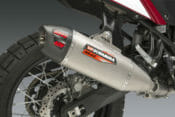If there’s one bike we’ve been salivating over for the last two years, it’s the Aprilia RS 660. Now, we finally got the chance to ride it.
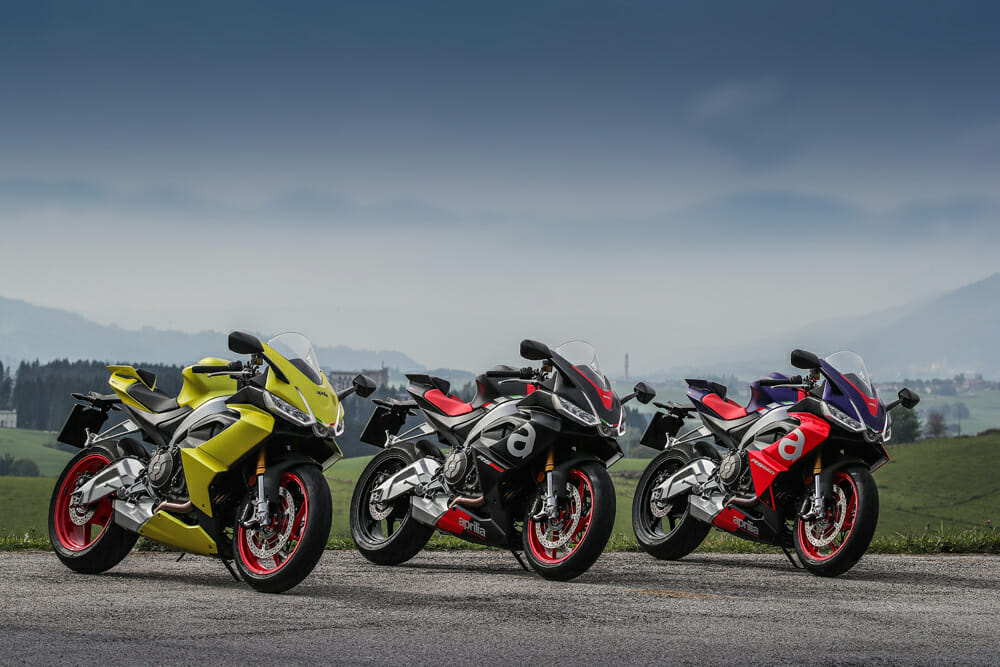
Photography by Milagro/ Alberto Cervetti, Rudy Carezzevoli
Ever since Aprilia displayed its RS 660 concept bike at the November 2018 EICMA Milan Show, the longed-for production version of this sexy-looking SuperTwin has been top of their what-if wish list for thousands of potential customers all over the world.
Last year’s Milan Show saw the production version of this delightful dream bike duly unveiled, scarcely any different than that tantalizing first taste of affordable performance combined with designer looks, whose specification and appearance—coupled with its compact build—heralds this as the modern day successor to the legendary RS 250 ring-ding two-stroke racer-with-lights, which was so sadly legislated out of existence back in 2004.
The RS 660 retails for $11,299 MSRP and is available in a choice of three distinct color schemes which Aprilia has christened Apex Black (derived from Marco Melandri’s 2002 RSV 250 World Champion machine, one of the 54 World titles won by Aprilia as recorded on the decal behind the ignition lock), Lava Red (inspired by the RSW-2 500 GP racer Loris Reggiani raced on in 1994), and Acid Gold—an ultra-distinctive yellow tint which makes any bike wearing it unlikely to be confused with anything else on the road—the RS660 costs less than half the price of the RSV4 1100 it’s derived from.
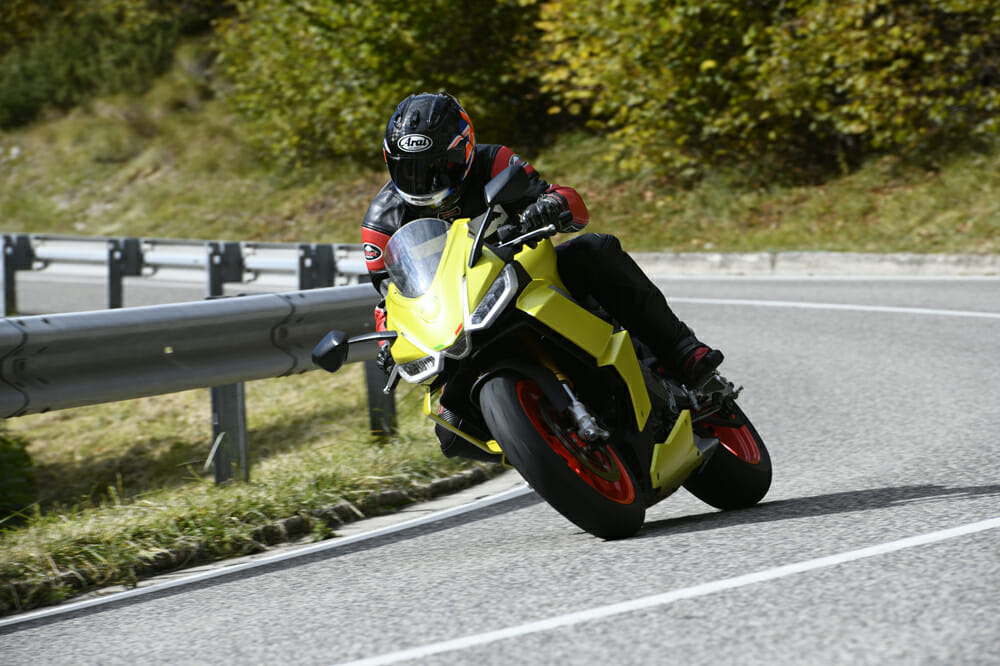
But in real-world terms, the RS 660 is infinitely more accessible than the old RS 250, and arguably just as thrilling to ride, even (or maybe especially) for more experienced riders, for whom the thrill of maxing out turn speed and optimizing such a bike’s handling capabilities, is much more of a buzz in real world terms than simply opening the throttle wide open and holding on tight.
Yet the RS 660 also excels by offering relative newbies or older returnees the chance to expand their horizons in riding terms on a bike that is far from intimidating, rather, simply enjoyable to be on.
Delivering a claimed 100 horsepower at 10,500 rpm while weighing just 372 pounds dry (or 403 pounds fully loaded with 3.96 gallons of fuel), with peak torque of 49.42 lb-ft on tap at 8500 rpm, the Aprilia RS 660 establishes a middleweight twin line in the sand that no other manufacturer has yet drawn—well, apart from Norton, with its 105 horsepower/348 pounds 650 Superlight which finished eighth on its race debut in the Isle of Man’s 2018 Lightweight TT, but is currently in abeyance while new Indian owner TVS figures out what to do with the bankrupt British company it’s now acquired.
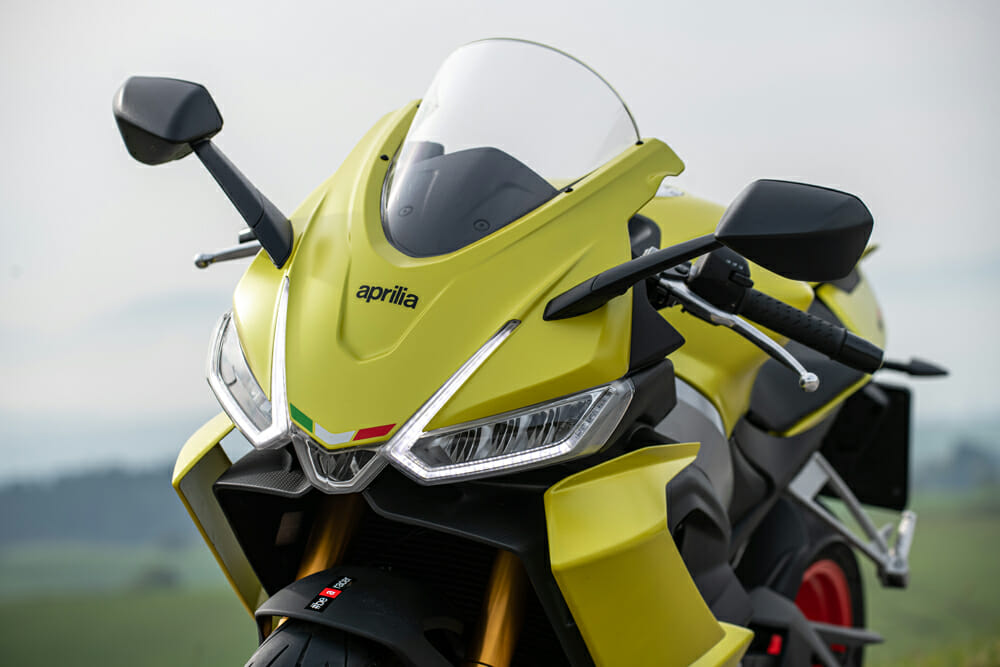
2021 Aprilia RS 660 Review | At Long Last
The chance to spend a day getting acquainted with a pre-production model at the press launch held high in the Dolomite Mountains north of Aprilia’s Noale HQ outside Venice, revealed a bike that rewrites the script for sporting street bikes, in proving that the old cliché that less can indeed be more still has some validity, after all.
For while the dynamic excellence of its engine performance and handling qualities are standout features, in a way the single most distinctive element in the RS 660’s makeup is its ultra-rational riding position and overall architecture. For this is a twin that thinks it’s a single, thanks to its svelte, slim build, centralized mass and short 53.94-inch wheelbase, which translates into nimble handling and agile steering, yet without sacrificing stability either on fast sweeping turns, or under the excellent braking delivered by its Brembo brake package.
Yet you have no sense when sitting aboard its 32.28-inch-high seat that the RS 660 is in any way cramped, or that you’re sitting perched atop it like on a more extreme 600 four or 675 triple supersport contender, which, until now, has represented the pointy end of the middleweight sportbike sector.
Instead, you feel that you’re sitting in the Aprilia rather than on it, and moreover the voluptuously shaped upper triple-clamp carries the flat-set handlebars (complete with large balance weights to offset vibration) higher than the top of the fully adjustable 41mm Kayaba fork legs.
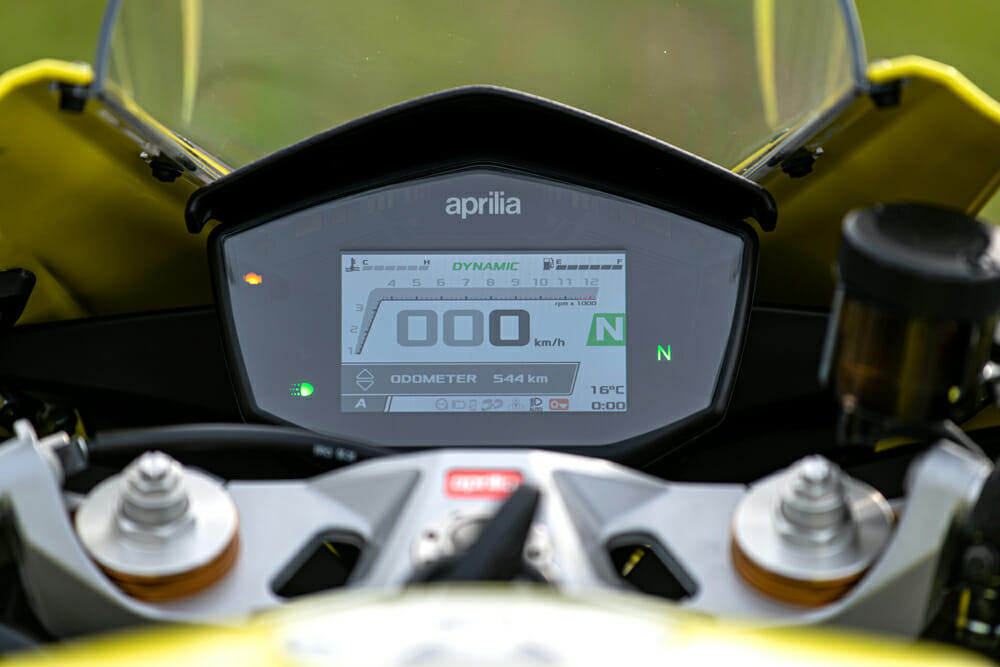
This means that, thanks also to the way the well-upholstered seat narrows where it meets the fuel tank, it’s not only easy, even for shorter riders, to put both feet flat on the ground at stop lights, you also don’t have any excessive body weight bearing down on your wrists or forearms.
The Aprilia twin has a balanced riding position that’s also relatively spacious, thanks to the quite low-set flip-up alloy footrests with a distinct ridge on the end so that your feet don’t slip off them. Yet these aren’t so low that ground clearance becomes a problem even with the excellent grip from the relatively skinny 5.50-inch rear wheel and 180/55-17 Pirelli Diablo Rosso Corsa II tire mounted on it, which contribute to the sense of agility endemic in the RS 660.
This is a very cleverly concocted motorcycle that’ll make riders of a wide range of statures, both male and female, feel completely at home. It’s also a truly versatile model which can most assuredly be used to commute to work during the week, before a weekend track day or Sunday morning blast along racer road.
Though its overall design is less extreme than the RSV4 it’s partly derived from, the RS 660’s aesthetics share an undisputed family resemblance with Aprilia’s world champion Superbike, which is not surprising, since both were the work of design teams headed by legendary progettista Miguel Galluzzi, who attributes the overall credit for the RS660’s gorgeous looks to Aprilia’s Noale-based long-time senior designer, Pietro Arru.
Aprilia’s trademark triple LED headlights are sharply positioned, and the daytime running lights wrapped around the two main headlights provide a distinctive facial signature to the bike. Direction indicators are integrated into the DRL profiles, making the front end even more compact, though for someone of my 5’9” stature there was space for me to tuck behind the domed screen that proved surprisingly effective in protecting me from windblast. Pity the high-beam flasher switch on the left bar was so easy to keep brushing on inadvertently!
The lighting system is also equipped with several features to make riding safer, so thanks to a twilight sensor the dipped beams are switched on automatically as it gets dark, while the self-cancelling turn indicators flash in the event of what Aprilia call ‘emergency braking’—or presumably if you get your imitation of Aleix Espargaro just right!
Finally, the cornering lights function sees two supplementary lights illuminate the inside of any curve. On the flanks of the bodywork, the double fairing also stands out (literally) acting as an aerodynamic appendage to improve stability, and divert hot airflow from the rider’s legs.
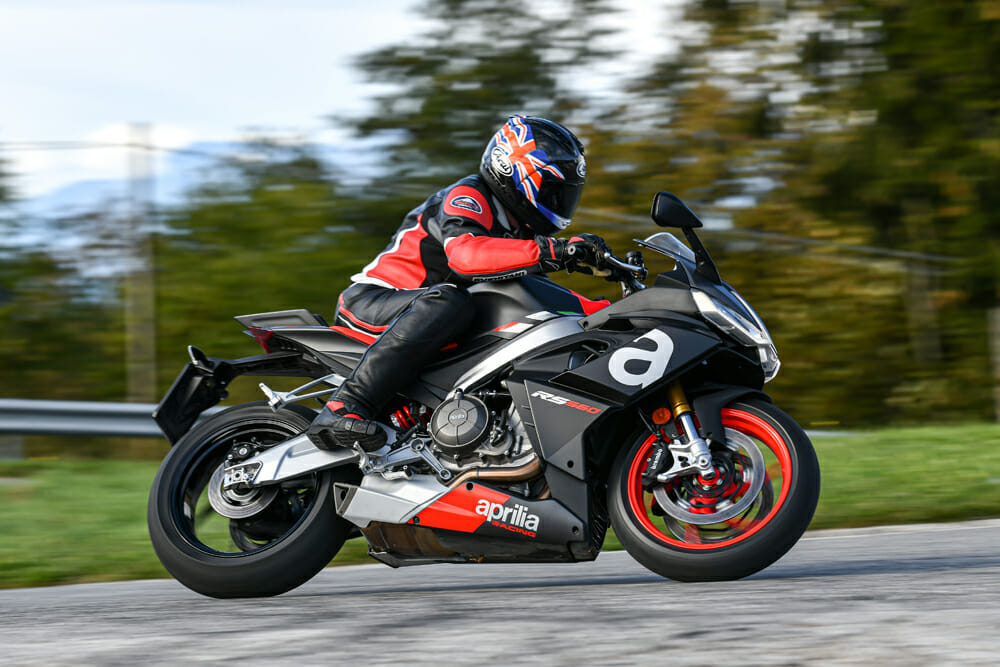
2021 Aprilia RS 660 Review | That Magnificent Motor
But the trump card of this middleweight marvel is its glorious engine. This all-new parallel-twin has an exhaust note that’s engaging from the very moment you fire it up, sounding more like an offbeat version of an old-style Norton Commando than the ‘pretend’ 90° V-twin Ducati soundtrack you’d expect its 270° crank to deliver.
It pulls smoothly away from rest with hardly any use of the cable-operated slipper clutch’s light-action lever, and starts to drive hard from just 2500 rpm before really taking off when the ultra-clear seven-inch TFT dash readout hits 4500 revs, and that gorgeous motor really comes on strong, with a totally linear pull to the five-figure limiter. Already at 4000 rpm there’s 80 percent of the peak torque already on offer, with 90 percent available at the 6250-rpm mark. This makes the Aprilia extremely forgiving and easy to ride hard, simply by surfing that super-flat torque curve and short shifting around 8000 rpm when it starts to top out. You’ll want to do that anyway, since above 6000 rpm there’s an increasing amount of vibration apparent through the footrests, which becomes uncomfortable above eight grand, when the otherwise excellent rear-view mirrors also start to shake a little. But using the sweet-action two-way quick shifter to hug that midrange torque curve makes the RS 660 improbably easy, and satisfying, to ride.
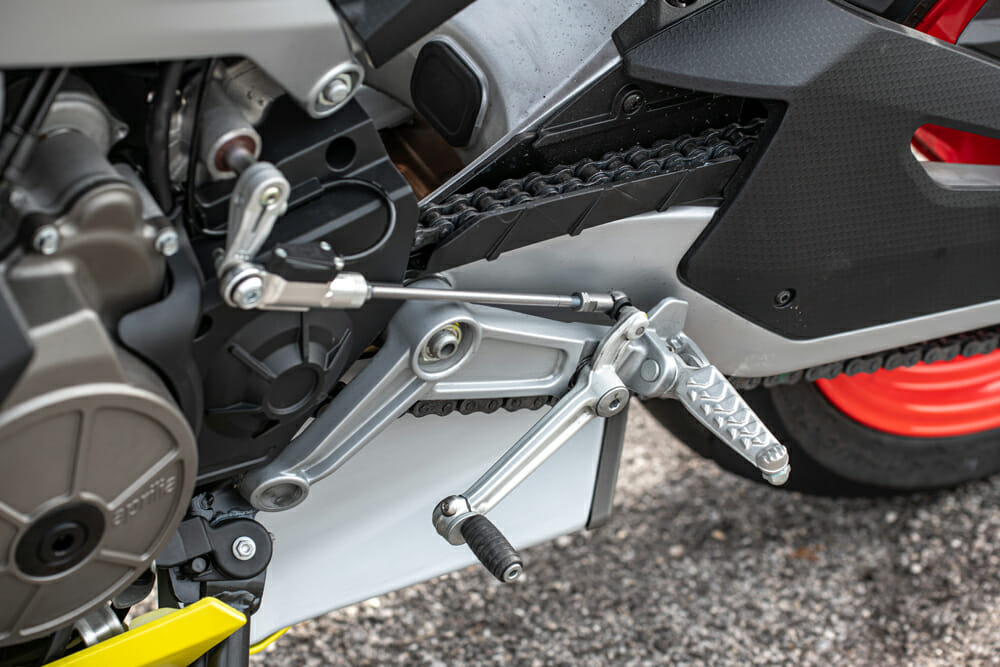
This is a bike which will turn less-experienced riders into pros because of its confidence inspiring ride qualities, and the ultra-accessible nature of its engine performance. And the more experienced will simply end up asking themselves if they really need twice as much horsepower from almost double the cubes to get real world satisfaction riding on public roads. The icing on the cake is the electronics, which typically for Aprilia are ultra-accessible (that word again) as well as very complete, and never invasive.
They are true rider aids which fulfil their purpose of helping you ride fast without imposing their electronic solutions on you. Commute Mode offers a gentler pickup from a closed throttle that I really appreciated on the ultra-slippery road surfaces we encountered early on after torrential overnight rain, which the weak autumnal sun took ages at altitude to dry out. But once that happened the sportier Dynamic mode came into its own, allowing you to relish the crisp acceleration and satisfying midrange roll-on in third and fourth gears especially.
The Aprilia twin’s throttle response and engine braking management allow you to get the best out of the engine in any context: its pickup is gentle in the wet, quick without being fierce in the dry, and it’s always satisfyingly responsive when you want to ride harder. The 100-mph mark sees the engine turning at just 7500 rpm, so just two-thirds of the way to that 11,500 rpm redline. This is going to be an absolutely superlative track-day bike, which, on a twisty circuit will eat 1000cc superbikes for lunch in the hands of a moderately skilled rider and deliver heaps of satisfaction, and fun, in doing so. Well, maybe not for the guy on the Superbike!
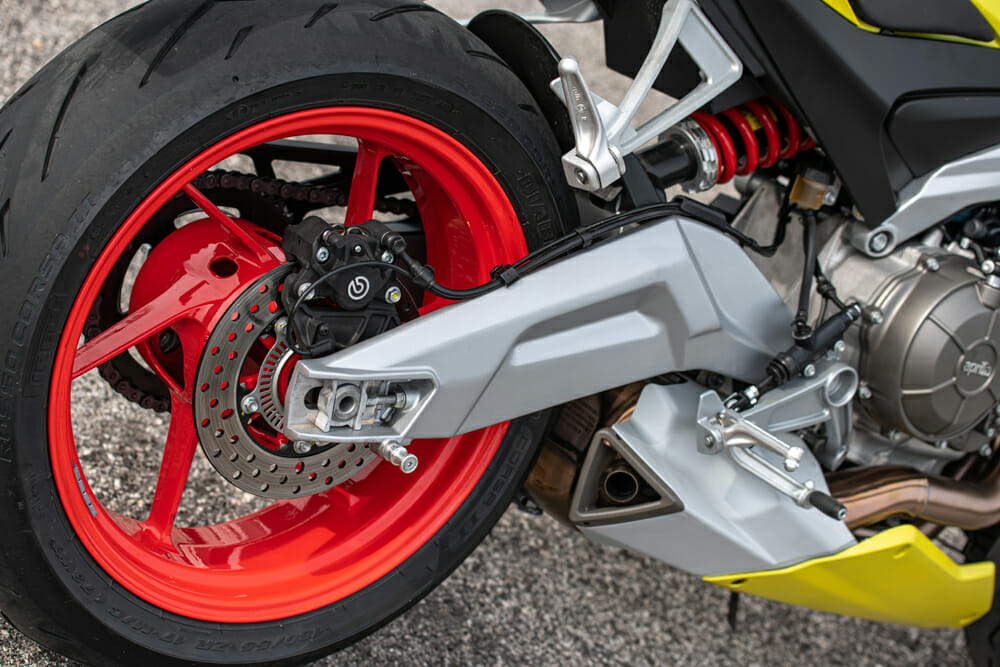
2021 Aprilia RS 660 Review | A Bike For All
Because it’s so ideally balanced and the steering geometry so well-chosen, the RS 660’s ultra-forgiving handling is completely intuitive, with excellent feedback from the front Pirelli thanks to the surprisingly compliant and responsive Kayaba fork that’s anodized to look like a far costlier Öhlins front end, yet was just about as effective in damping out the many bumps and lumps in the Dolomite road surfaces, while allowing you to maximize the lightweight bike’s appetite for turn speed once the roads dried up.
The default suspension settings we were given were excellent, an ideal balance between an effective and stable bike in mixed conditions—which while fairly tautly damped was also comfortable in city streets torn up by traffic or frost-ravaged mountain roads, where ride quality was quite satisfactory by sportbike standards. It’s also very maneuverable, with an improbably tight turning circle for a fully faired motorcycle.
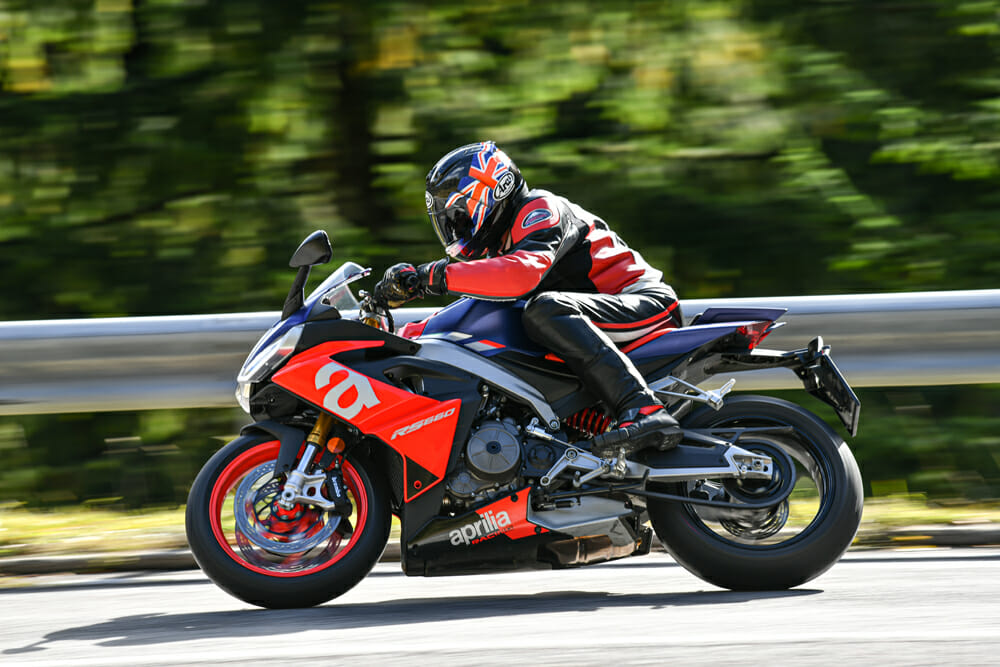
Like most previous Aprilia designs the well-designed, full color TFT dash is very readable at a quick glance, with the different pages of data easily available—though scrolling through them is best done at rest.
But the home page has just enough data to avoid being overcrowded, with a large central digital speedo, a quickly legible gear-selected readout on the right, the time and trip (of two) selected on the bottom right, and the tacho sweeping across the top of the speedo, then the engine temp and fuel level above that. There are six warning lights across the bottom of the screen, but a total of no less than 17 all told dotted around the dash outside the screen. There’s no risk of being under-informed riding this motorcycle!
Despite the speed with which it is been readied for production since that unveiling of the showbike version two years ago, the RS 660 gives every appearance of having been very carefully refined, with the result that it seems bursting with quality, rather than built down to a price. Apart from the high-beam headlight switch (every bike at the launch seemingly suffered from this small but irritating fault) the only issue with the bike is that although the front-brake lever is fully adjustable for span, the cable-operated clutch lever isn’t, and is a bit far away from the bar for those with smaller hands. Oh, and that pillion pad looks like a medieval torture instrument! But that’s all. Honestly, I defy you to go to your nearest Aprilia dealer for a test ride—and the company understands that having test bikes available is absolutely central to the RS 660’s commercial success—and find further fault with a motorcycle which is essentially inventing an all-new category, and doing so in superlative fashion.
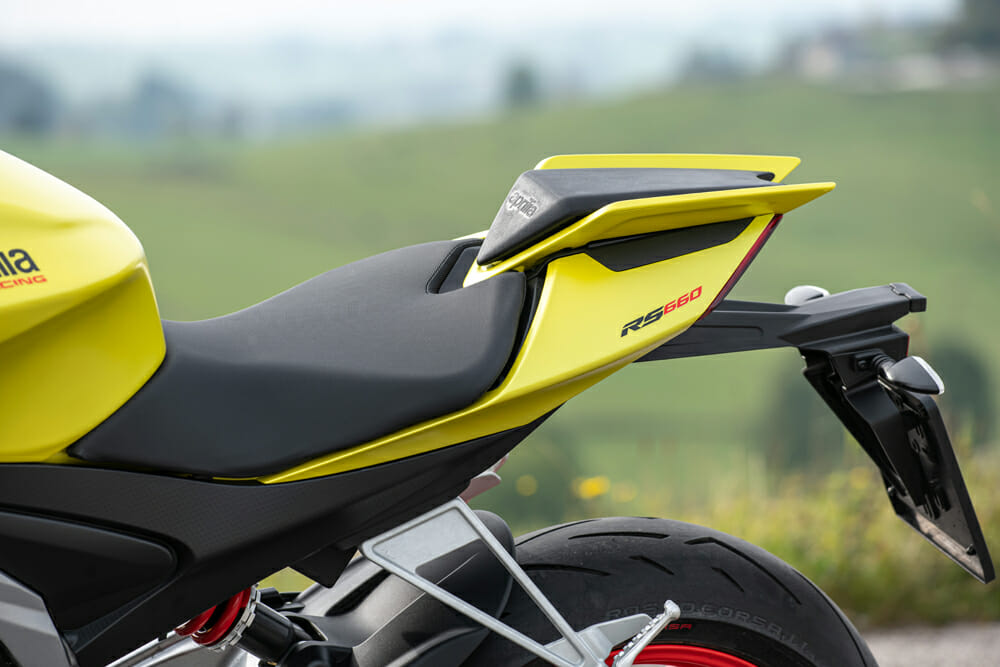
Balanced and effective are the two words that best sum up this very significant new Italian motorcycle, which is set to lead the field in ushering in a whole new generation of middleweight capacity sportbikes. For Aprilia has a 95-hp Tuono 660 waiting in the wings that’s due to be launched in the global marketplace next February, with a Tuareg 660 adventure tourer coming after that. This all points to nothing less than a long-overdue revival of the Aprilia brand with an exciting range of the appealing middleweight models it’s essentially lacked in recent years.
This bike puts Aprilia back in business big time—believe it!CN
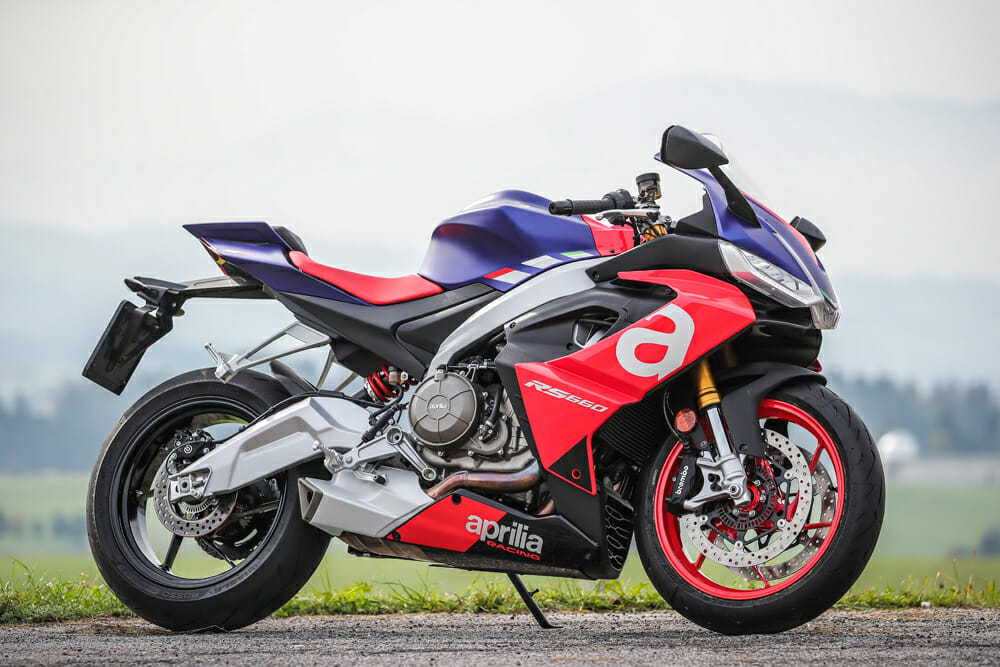
2021 Aprilia RS 660 Specifications
| MSRP: | $11,299 |
| Engine: | Aprilia parallel 2-cylinder forward facing, 4-stroke, liquid-cooled with water-oil radiator and heat exchanger, DOHC, 4 valves per cylinder |
| Displacement: | 659cc |
| Bore x stroke: | 81 x 63.9mm |
| Fuel injection: | Electronic fuel injection system. Full ride-by-wire 48mm throttle bodies |
| Compression ratio: | 13.5:1 |
| Power (claimed): | 100 hp at 10,500 rpm |
| Torque (claimed): | 49.4 lb-ft at 8500 rpm |
| Exhaust: | 2-into-1 |
| Transmission: | 6-speed w/ Aprilia Quick Shift |
| Clutch: | Multi-plate wet clutch w/ mechanical slip system |
| Electronics: | 6-axis inertial platform, APRC package containing ATC (Aprilia Traction Control), AWC (Aprilia Wheelie Control), AEB (Aprilia Engine Brake), AEM (Aprilia Engine maps) and ACC, (Aprilia Cruise Control); five Riding modes (Road and Track, three fixed and two customizable) |
| Chassis: | Aluminum dual beam chassis with removable seat support subframe |
| Front suspension: | Kayaba 41mm fork, aluminum radial caliper mounting bracket, fully adjustable |
| Rear suspension: | Aluminum asymmetric swingarm, fully adjustable |
| Front-wheel travel: | 4.72 in. |
| Rear-wheel travel: | 5.12 in. |
| Front brake: | Brembo radial calipers 4-piston; cornering ABS |
| Rear brake: | 220mm disc, 2 piston Brembo caliper; cornering ABS |
| Front tire: | 120/70 ZR17 |
| Rear tire: | 180/55 ZR17 |
| Rake: | 24.1° |
| Wheelbase: | 53.9 in. |
| Seat height: | 32.3 in. |
| Fuel capacity: | 3.96 gal. |
| Weight (wet, claimed): | 403 lbs. |
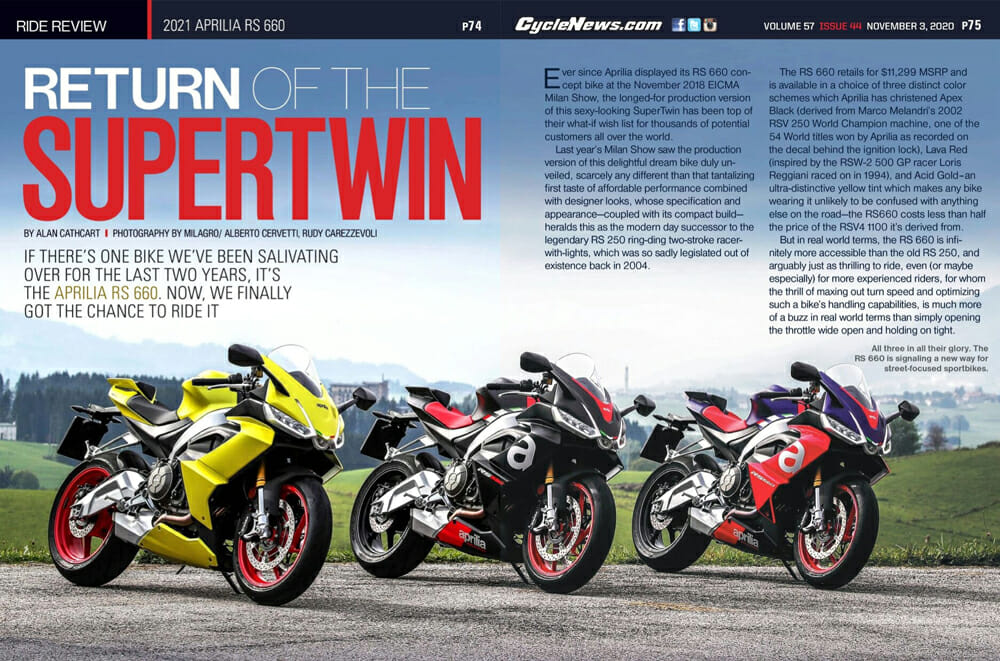
Click here to read the 2021 Aprilia RS 660 Review in the Cycle News Digital Edition Magazine.
Click here for the latest Cycle News Sportbike motorcycle reviews and news.
Click here for more Aprilia motorcycle reviews and news.
